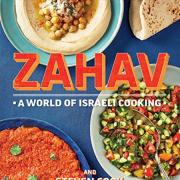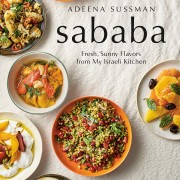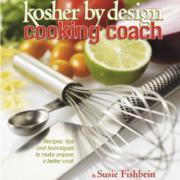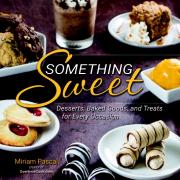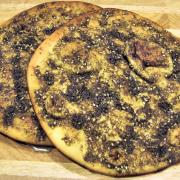Zahav Cookbook by Michael Solomonov. My Book Review
Zahav Cookbook. Treat yourself to a copy. Well priced too!
Congratulations and Kudos to Michael Solomonov for his delightful just-published Zahav Cookbook, named after his eponymous Restaurant. Michael’s sterling reputation as a multi-restaurant owner in Philadelphia precedes the book by several popular venues. Zahav Cookbook is so beautiful, simple and straightforward I have already gifted it to myself, my daughter and my niece, with the good problem that when I brought it to them they nearly forgot about their guests at the table and leafed through the book excitedly and made a list of all the delicious dishes they were going to make.
I have a friendly but important factual clarification to make. On page 78 of Zahav Cookbook, in the Salatim Chapter, Michael writes: “The custom of starting the meal with fresh salads originated with the Palestinians“. I beg to differ. No it has not originated with the Palestinians. For centuries, Moroccan Jews and Arabs (including yours truly) have served no end of small cooked and raw salads before every meal, with even more lavish displays on Shabbos and Holidays. All Sephardis – from Morocco and beyond – who have resettled in Israel and indeed everywhere in the world have carried the multiple-salad-course torch, to the delight of their grateful Ashkenazi neighbors. I trust this will set the record straight. All I can say is, Thank Gd my old and frail mother AMV, the original master who made the salad course alone look like a banquet in its own right, will most likely not see that line!
Now that we had this little talk, let’s move on to Zahav Cookbook in earnest. Several elements make the book captivating and admirable:
– You will find it virtually impossible to separate the man from his food.
I smiled fondly and proudly when I first saw Michael’s book, as I remembered the two of us working as a team for cooking demonstrations I was invited to give one long weekend at the Isabella Freedman Retreat a couple years ago.
Michael’s book is a perfect emanation of him, as he is completely engaged, in the kitchen and way beyond. Several Cookbook Authors have lately devoted themselves to the subject of Israeli Cuisine, even while reiterating strenuously that Israeli Cuisine (and all Jewish Cuisine for that matter) should not be construed as Kosher but indeed as secular, and that the Kosher Readership is the last thing they had in mind, un-viting us with every insidious hint they can dream up, such as appending many meat dishes with a yogurt sauce, like passive-aggressive bouncers of sorts (Just wondering: which of us is not inclusive here?)
In my view, the great deficit this thoroughly secular perspective on Israeli Cuisine begets is that many dishes in Israeli Cookbooks are assuredly delicious, but have been mostly stripped of their history, anecdotal backdrop and personality: much like playing a beautiful piece with no feeling, “from the head up” as they say in artistic circles. In contrast, I find it very refreshing and most considerate that, although neither Michael’s restaurants nor himself keep Kosher, Zahav Cookbook is thoroughly Kosher-friendly, with no “Treif” interloper dish of any kind, just because, as he explains, the Kosher factor is inextricable from the Jewish factor, as we have received Kosher Laws with the Torah millennia ago.
– Michael is one of those rare authors that writes his cookbook as a personal journey
He chronicles determining milestones ranging from tragic to serendipitous, and weaving them poignantly, family pictures and all, into all the steps that lead him to his present resounding success.
In Zahav Cookbook, no recipe stands alone
It always tells a story. Tehina, that deceptively plebeian spread so ubiquitous all over the Middle East is suddenly not just street food to dunk your bread in; Tehina is awarded a whole chapter with gorgeous pictures, how the tehina paste is made, a display of tehina spread each region in the Middle East is famous for, including a tehina-walnut sauce called tarator, a green tehina herb dip, tehina cookies and tehina semifreddo, and several main courses made with tehina-based sauces. Calling all tehina lovers: Boy you’ll be happy!
– Zahav Cookbook displays Sephardi Salads Gloriously
All of us Sephardi expats and all honorary Sephardis alike will be delighted to find right in the beautiful pages of Zahav Cookbook the great display of Sephardi little salads, or Salatim as they are called in Israel, that come with every Sephardi meal, and whose ingredients are quite simple to procure.
Zahav Cookbook asks just one thing of us: Use only the best.
That is perhaps best illustrated in his Israeli Salad Recipe: Can’t find perfect tomatoes to make Israeli Salad? No problem: substitute perfect mangoes for imperfect tomatoes. Get this: A perfectly smooth and limpid Israeli Salad Martini! Likewise, Tabbouleh wears several hats, as in the kale, apple, walnut and sumac-onion Tabbouleh, or quinoa, pea and mint Tabbouleh.
Needless to say, all salads, as indeed every single recipe in the Zahav Cookbook, is vibrant, fresh and healthy, with no end of gorgeous photography to illustrate each dish. Michael restores and vindicates the wholesome high Plant-Food-Protein ratio the way we Mediterraneans grew up with, the way it should be used on a daily basis, for any occasion, both casual and formal. Humble street food at its most glorious!
– Meat dishes are all accessible and affordable.
The Grill Chapter is pure seduction; I nearly fainted when I read about Foie Gras and Duck Kebabs (somewhat less affordable, just about the only exception)
Michael’s message rings clear throughout the book: A feast needn’t be expensive or complicated: It needs only be genuine, seasonal, honest and authentic. Incidentally, Zahav Cookbook has a decidedly Sephardi feel, its assertion of giving equal culinary time to every cuisine and culture in Israel notwithstanding. But here is one perplexing fact: No Moroccan Couscous dish anywhere in the book! Like leaving Mozart out of a music repertoire. What gives?
– Soups are most interesting, albeit scant in their selection, and broth-y and dumpling-y rather than hearty and chunky, except for the beloved Yemenite Soup Classic.
– A whole chapter on Borekas, and a whole Chapter on Challah, walking you step by step to make all these treats from scratch the simple and healthy way.
– The Persian Rice Chapter is the one I will most resolutely stay away from.
I am terribly sorry to confess I find it bewildering that Persians fuss so much with their rice, the rinsing, the draining, the steaming, the covering, the draining again, the sticky bottom, the crust, the crunch, the burn. To me it sounds like a recipe for OCD Type-A Cooks. I don’t even care how delicious that rice is going to be at that point, I just can’t see obsessing about rice up to this critical point. Dearest friends, go right ahead, work your tail off and make Persian rice, and make it for me sometime: I will eat it with pleasure, but I am not making it, nonononono not going there. On the other hand, I can live happily with the following chapter, Rice Pilaf, and all its variations, thank you very much.
– The Dessert Chapter is short and sweet, so to speak
It is dominated by Classic Sephardi Vintage, if only in looks. All our favorites are there, and we can make them all, without fuss and without fear: rugelach, basboosa, baklava, babka, konafi, honey cake etc..
Dear Michael and Steven, I wish you great success with your beautiful Solid Gold Zahav Cookbook. And if some day you find it in your heart, or in your business plans, to open a Kosher Restaurant, give me a holler, will you? Gd Willing I and quite a few Kosher Foodie Friends, KFF as I call us, will be there with bells on, to feast on your wonderful food!

